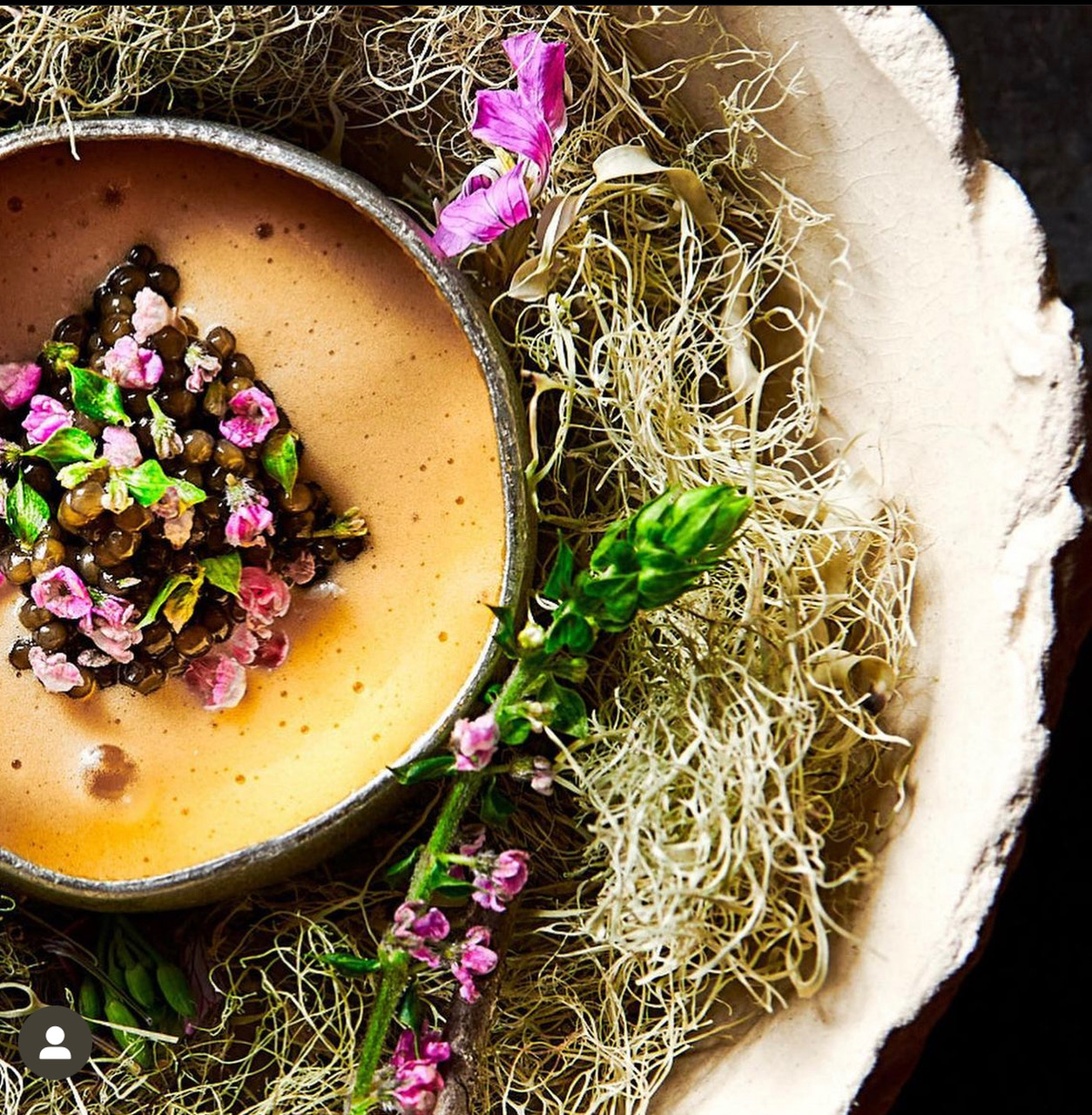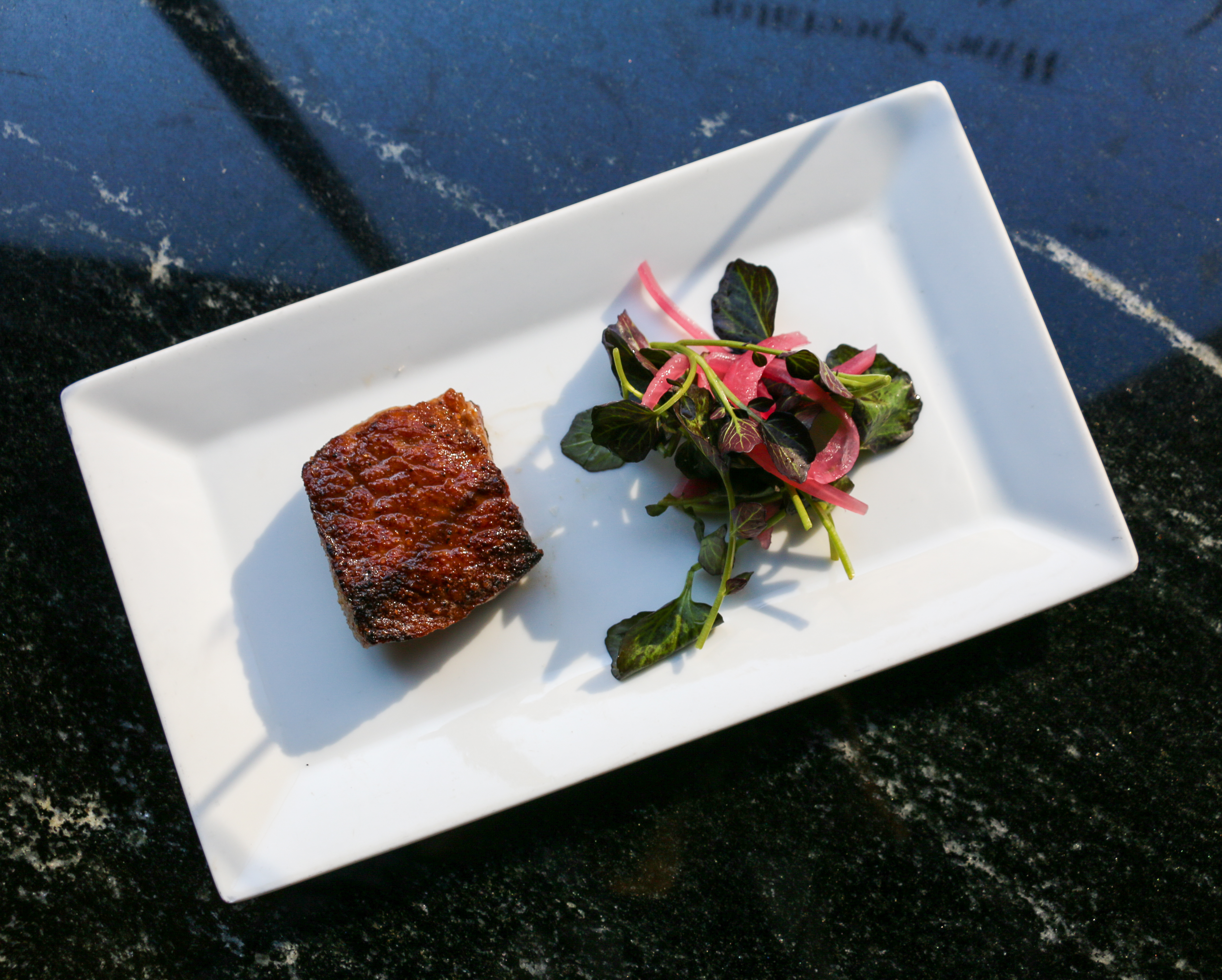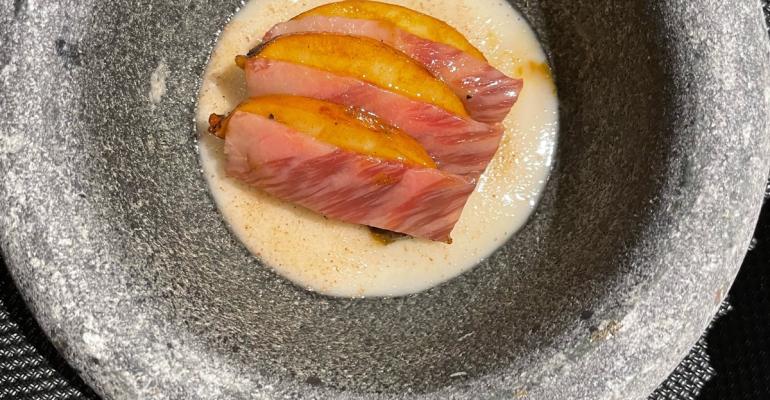Inflation, general economic and political woes, and other difficulties have caused lower-income consumers to pull back on their spending in recent months, but the luxury market is still going strong as consumers looking to treat themselves are showing a willingness to pay for great experiences.
A case in point is wagyu. Literally meaning “Japanese beef,” the super-premium meat is trending both in restaurants and in grocery.
“Wagyu is everything you could ever want when cooking beef,” said Brandon Rice, chef and owner of Ernest in San Francisco. “Because of its high intramuscular fat, wagyu has a much richer flavor than other beef.”
Wagyu consumption in retail rose by 153% between August 2020 and August 2022, Maggie O’Quinn, business development manager of meat marketing firm Midan, told attendees of the American Wagyu Association’s recent conference in Charleston, S.C. O’Quinn acknowledged that part of that increase was due to more consumers eating at home at the height of the pandemic, but she said the meat is proliferating on restaurant menus, too, spreading beyond high-end steakhouses and premium Japanese restaurants to those with more modest price points. She cited menu research firm Datassential as saying wagyu’s presence on restaurant menus had grown by 27% in the four years prior to August 2022.
Brazilian churrascaria chain Fogo de Chão in March added shareable cuts of American wagyu to its à la carte Bar Fogo menu. A 20-ounce broiled New York strip aged for 21 days and intended for four or more people starts at $135, and a 24-ounce 21-day rib eye for four starts at $145.
On the much lower end, quick-service chain Arby’s offered a Wagyu Steakhouse Burger this spring and summer starting at $5.99. It was made with a 6.4-ounce beef patty made with 52% American wagyu and 48% standard ground beef cooked in sous-vide and then fried and topped with American cheese, shredded lettuce, tomato, pickles, red onion and a special burger sauce on a toasted brioche bun.
Not all wagyu is the same. First introduced to the American mainstream as Kobe beef, named for the Japanese city near where that particular wagyu variety is raised, many parts of Japan, from Hokkaido in the far north to Kyushu in the deep south, raise one or more of the four authorized breeds of wagyu. Beyond that, other countries, including Australia, New Zealand, and the U.S., raise wagyu, too, although outside of Japan it’s generally crossbred with Angus or other faster growing breeds. The result is beef with more marbling than other premium steaks, but less than purebred Japanese varieties raised on their home islands, particularly those graded at the top rating of A5.
Japanese A5 is what Rice uses at Ernest for his Wagyu Sandwich with Alabama White Sauce. He breads 5.5 ounces of the meat in panko breadcrumbs, sears it and serves it between two pieces of buttered and toasted Japanese milk bread with tangy mayonnaise-based sauce. He charges $73 for it.
Every course at tasting-menu restaurant Ittoryu Gozu in San Francisco has some sort of Japanese wagyu.
“The fat melts when you cook it, leaving behind a soft, juicy cut of meat that is super tender when you bite into it,” he said, noting that the irritating situation in which the steak in sandwiches is too tough, making it hard to eat, is never a problem with wagyu.
“I believe every [type of] wagyu tastes different,” said Taishi Yamaguchi, executive chef of Katsuya NYC, an upscale Japanese restaurant. He offers an Australian wagyu rib eye that Yamaguchi said is a hybrid of Miyazaki wagyu, from the southern Japanese island of Kyushu, and black Angus. The 14-ounce steak is finished on super-hot Japanese binchotan charcoal with Maldon salt and a soy sauce spiced with chile oil and shichimi peppers. It’s priced at $95.
“It has more red meat than the regular [Japanese] wagyu, so it tastes great as a steak, and you can eat a lot of it, like a regular T-bone,” he said.
That’s in contrast to the Miyazaki A5, which Yamaguchi plans to bring back for the winter, when it’s most popular. It’s sold in slices of 2-3 ounces each. He said he doesn’t yet know what the price will be.
In general, A5 is priced by the ounce, often in the $30-$70 range, although it varies, and most restaurants require customers to buy at least three or four ounces.
Yamaguchi said that even among Japanese wagyu the flavor can vary widely, since they are fed with local ingredients.
Ayaka Matsui, who is spearheading a campaign by the Japan Food Produce Overseas Promotion Center, or JFOODO, to promote Japanese wagyu, said different parts of Japan follow different practices. For example, on Shodoshima island in Kagawa prefecture, where olive oil is made, the cattle are fed the spent olives.
“It’s a specialty of that place,” she said.
Grill 23 in Boston sells both Japanese A5 and American wagyu.
Elsewhere they’re fed the spent barley from beer production, or the spent rice from making sake.
Brand, culture, and experience expert Leiti “Dining Dominatrix” Hsu, who worked with Matsui to design a multi-city campaign promoting Japanese wagyu, said they worked to change the notion of what the beef is.
“We extended the conversation beyond Japanese cuisine, beyond expected price point,” she said, showing the possibilities of applying global flavors and techniques to the meat, as well as using cuts beyond those traditionally used in steak.
Hsu added that wagyu can also be part of a broader sustainability conversation, because eating a small amount can be enough.
“It’s different from other beef. The fat pops in your mouth the way a really ripe pomelo would ... or caviar. … Wagyu presents an opportunity to have the best-quality meat and still be cost-effective,” she said.
Chef, restaurateur, and steak expert David Burke also believes that wagyu isn’t ideal to eat as an American-style steak because it’s so rich.
“[Japanese] wagyu I can eat as an appetizer, like foie gras, but not for dinner,” said Burke, who among his many other jobs was corporate chef of the Smith & Wollensky steakhouse chain. Today, he and his team operate or manage 15 restaurants in the U.S., including David Burke Tavern in New York City, where he occasionally offers a wagyu-Angus hybrid steak from Bluegrass F1 Wagyu in Kentucky for around $50.
That ranch only produces 48 head a year at the moment, but Burke buys a whole animal, braises the shanks, broils the steaks and uses the rest to make burgers, meatballs, and more.
“Americans like to chew their meat,” he said, noting that it’s lacking in pure Japanese wagyu.
He cooks the F1 steak Smith & Wollensky-style, starting it cold and putting it directly in the broiler.
Ryan Marcoux, chef of Grill 23, a high-volume fine-dining restaurant in Boston, sells a lot of both Japanese A5 and American wagyu.
The A5 is Black wagyu from Kagoshima Prefecture, for which he uses the sirloin. The American variety is rib eye cap from Snake River Farms in Idaho. Both are broiled at around 1,000 degrees Fahrenheit and then pan-seared to finish them. A 2-ounce A5 appetizer is $54 and 6-ounce entrée is $162.
“We do sell a good amount of it just because of the numbers that we do, but the vast majority aren’t buying it. The wagyu is a treat for sure,” Marcoux said.
So is the Snake River Farms product, at $110 for 10 ounces, but “we sell a lot of that,” the chef said.
“The biggest thing to recognize is that American and Japanese wagyu are not the same thing. There are a lot of people who get those lines sort of crossed. They’re delicious in their own way.”
“An A5 is like eating butter,” he added. “It’s very, very soft in texture and that’s due to the intramuscular fat. It’s like eating oysters. I wouldn’t try to fill up on them.”
The Grill Room at the Windsor Court Hotel in New Orleans uses Chateau Uenae wagyu from Hokkaido. That particular type of wagyu is called “snowflake beef,” according to Igor Krichmar, the Windsor Court’s former culinary director who established its wagyu program. It got that name both because of the snow climate in which it’s raised, but also because “it melts on your tongue. It’s like eating snowflakes.”
It's grilled over binchotan and sold for around $65 per ounce, with a four-ounce minimum.
Marc Zimmerman, chef and owner of Ittoryu Gozu — a tasting-menu restaurant in San Francisco for which every course has some sort of Japanese wagyu — also is using Chateau Uenae.
“At Gozu our tasting menu focuses on utilizing the entire animal and is done so with respect, balance, intent and an ultimate goal of sharing the nuance of flavor and the versatility of the breed with our guests,” he said.
One dish that is indicative of their approach, he said, is called Caviar Soba. Kaluga caviar rests on silken tofu that has been infused with toasted buckwheat. “We add chives, wasabi, shiso, and lemon and finish with a sauce made from the lean trim of the animal that has been fermented with koji,” he said.
Another dish they’re offering is Monterey bay abalone, sunchoke and wagyu bacon. The abalone is grilled over wood coals, sliced and layered with wagyu short rib that has been cured and smoked. Is sits on top of fire roasted sunchokes that are dressed in a sauce of abalone liver tare. The dish is finished with a purée made with sunchoke and a broth made with the trim of the bacon.
Contact Bret Thorn at [email protected]
Follow him on Twitter: @foodwriterdiary




